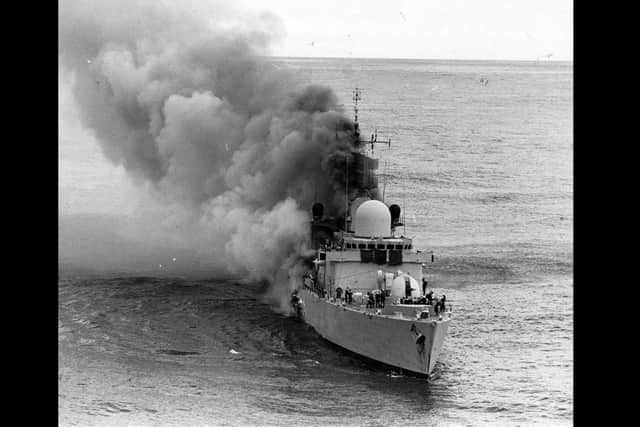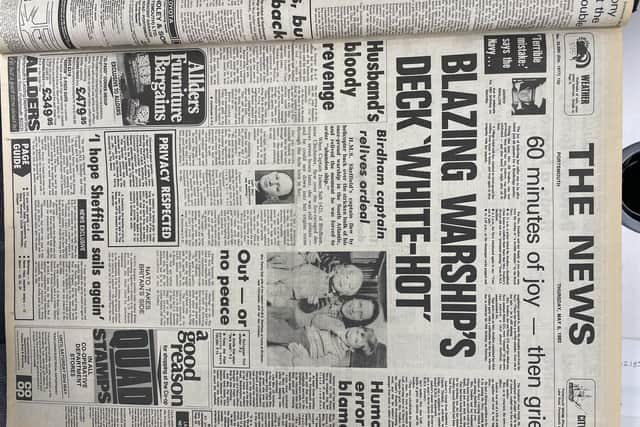Falklands 40: Headlines from The News, Portsmouth, May 6, 1982
and live on Freeview channel 276
Blazing warship’s deck ‘white-hot’ – Birdham captain relives ordeal
HMS Sheffield’s captain flew by helicopter back over the stricken hulk of his once-proud warship in the South Atlantic, and relived the moment he was forced to order “abandon ship.”
When Captain James Salt, 42, of Birdham, near Chichester, flew over the fire-ravaged destroyer seven hours later, she was still ablaze - and he could see down into her engine room through the hole torn in her.


Advertisement
Hide AdAdvertisement
Hide AdShe was mortally wounded because the missile that hit her tore through two compartments - then exploded upwards and outwards, he said.
Last night, the Sheffield was reported to be still afloat, and her fires had subsided.
About abandoning ship, Captain Salt said: ‘It was my decision and I feel awful about it. But there was no alternative.
‘We could feel the heat of the deck through our shoes, the superstructure was steaming. Paint on the ship’s side was peeling off. The area where the missile penetrated the hull was white-hot,’ he said.


Advertisement
Hide AdAdvertisement
Hide AdAnd he praised his crew, who remained calm and retained “common sense and careful thinking.’
He said: ‘The men were quite incredible. I have no doubt that the ship’s company saved themselves by their own sensible efforts.’
Captain Salt, married with two sons, said morale among the crew was at an incredibly high level, and team-work was “exceptional.’
The destroyer was abandoned on Tuesday after being hit by a missile in an Argentinian air raid on the Falklands task-force.
Human error blamed
Advertisement
Hide AdAdvertisement
Hide AdHuman error has been blamed for the Royal Navy mistake that left families of some Sheffield crewmen devastated.
At least three families in the Portsmouth area were told that sons or husbands serving in the Sheffield were safe, only to be informed later that they were still missing, feared dead.
Lists were confused by Navy staff responsible for keeping relatives informed.
‘It was a mix-up, a human error on our part,’ said a Ministry of Defence spokesman. An enquiry has been ordered.
Advertisement
Hide AdAdvertisement
Hide Ad‘We deeply regret what has happened,’ said the spokesman. ‘We hope we can learn from our mistakes.’
‘I hope Sheffield sails again’
The man who designed the doomed destroyer H.M.S. Sheffield said today: ‘I hope she’ll sail again.’
Mr. Kenneth Purves, who led the drawing board team that created the Type 42 Sheffield-class warships, was speaking after Argentinian planes had crippled the Portsmouth-based destroyer with a fearsome Exocet missile assault.
He said he was stunned at hearing of the attack, and could not understand how so much damage had been done.
Advertisement
Hide AdAdvertisement
Hide AdSaid Mr. Purves: ‘I heard the news on the radio - originally she was reported sunk - and that absolutely shattered me.’
But with later news that Sheffield was still afloat, Mr. Purves expressed hope that she would rise phoenix-like from her crippling blow.
‘Let me be your guide’
The city of Portsmouth is rich in history, maritime and otherwise, but a Horndean man claims that not enough has been done to inform the ordinary holidaymaker.
Mr. Nicholas Pine says no commercial guidebook on Portsmouth’s history is produced by the city, so he has commissioned local historian, Mr. Ronald Brown, of Gosport, to write a guide.
Advertisement
Hide AdAdvertisement
Hide AdMore than 1,000 copies were sold on the first day by bookshops, hotels, car hire firms, ferry operators and major department stores.
Not only Portsea Island, but Hayling, Gosport, Titchfield, Portchester and Portsdown Hill are described in the 56-page booklet with 31 photographs and engravings.